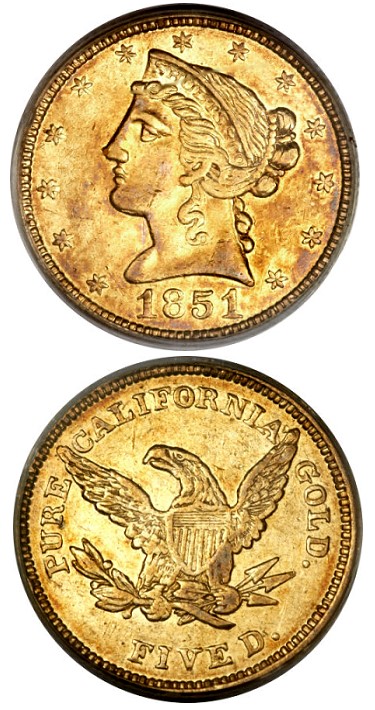In the hectic atmosphere of the California Gold Rush, many partnerships were made and broken in a matter of months. Some have been immortalized, as through the discovery of the S.S. Central America treasure, while others remain obscure. Though it is not as mystery-shrouded as, for example, the Cincinnati Mining & Trading Co., the firm of Schultz &. Co. is remarkably enigmatic for a central player in the field of private California gold coinage.
It is little-known, except perhaps among devotees of California gold, that many of the firms who issued private coinage did not make their own dies. While the “Moffat complex” (Moffat, Humbert, U.S. Assay Office, etc.) did so, other firms turned to Schultz & Co., which began in September or October 1850 not as an assaying firm but a brass foundry. As often was the case with partnerships during the California Gold Rush, there was a significant difference in the principals’ ages and what they brought to the firm. Judge G.W. Schultz, today the more obscure figure, had the reputation and financial capital to set up the foundry. He tapped William T. Garratt, a youth in his early twenties from Cincinnati who had learned metalworking in family trade, to handle the back end of the business.
 Said business proved enormously profitable for Schultz & Co. Garratt later recounted, in a dictated statement published by Edgar Holmes Adams in Private Gold Coinage of California, 1849-55, Its History and Its Issues:
Said business proved enormously profitable for Schultz & Co. Garratt later recounted, in a dictated statement published by Edgar Holmes Adams in Private Gold Coinage of California, 1849-55, Its History and Its Issues:
“We made a great many dies for private coining. Albert Küner, who is still in business here, would do the engraving and I the turning — that is, the machine-work on the dies — for which at the time we would get $100 per day per man on that special job.
“After that, Shultz [sic] took a notion to go into coining for Burgoyne & Co. and Argienti & Co. who were bankers here at that time. They would buy the dust and we would do the coining. We ran for a while, and then Shultz and I separated, he taking the coining establishment and I the foundry…”
It is to be noted that spellings of names often were inconsistent at the time, with “Schultz” and “Shultz” given by different sources. The spelling “Shults” on the coinage itself, however, is singular and almost certainly an error on the part of Mr. Küner, a Bavarian by birth whose long career included a brief stint engraving for Charles Lewis Tiffany (of Tiffany & Co. fame) and the first version of California’s Great Seal. Garratt himself was not immune to misspellings, being listed as “Garrett” in sundry places.
An assay by Augustus Humbert showed that the Schultz & Co. five dollar coins, far from being “Pure California Gold” as the reverse legend proclaimed, were alloyed with copper (Garratt gave the figure at 10%, “just enough to make the coin hard enough to wear”), and further, underweight; when word spread, the coins’ reputation went to tatters, and a more favorable assessment made at the Philadelphia Mint by William E. DuBois in 1851 came too late. Many of the Schultz & Co. coins were destroyed, and Schultz’s coining operation was halted by the California Legislature’s prohibition on the striking of private gold coinage on April 21, 1851.
As noted above, the Schultz & Co. firm had dissolved the same month, and while Judge Schultz was left with a worthless coining operation, William T. Garratt still had the foundry, his knowledge, and his business connections. Garratt persevered through the Great Fire that swept through San Francisco in early May 1851 and several other business-destroying disasters to establish W.T. Garratt & Co., a foundry whose bells were installed in churches, fire stations, and schools all around California both before and after his death in 1890.
The bells bearing Garratt’s name today are far more numerous than the coins bearing Schultz’s. None of the rumored ten dollar coins by the same firm ever have shown up, and as for the five dollar pieces, the cataloger for The Louis E. Eliasberg, Sr. Collection, source of the present piece, gave a census of 15, whereas Heritage suggested 10 to 12 pieces in all grades when it offered an NCS AU Details example as part of The Great Western Collection of Territorial Gold in July 2005. NGC has only two entries in its Census Report, an AU53 and an MS62, while the 10 PCGS Population Report coins range from VF20 to AU53.
Heritage will offer the 1851 $5 Schultz & Co. Five Dollar AU53 PCGS. CAC as Lot 5957 at Platinum Night in their 2013 August 8-10 US Coins Signature Auction in Rosemont, IL.
Originally listed as “EF-45 to AU-50” in the Eliasberg Sale (May 1996), this coin’s green-label PCGS holder gives a grade of AU53, with CAC reaffirming that value by a green sticker. The dies are an early state without the cud over GOLD on the reverse. Yellow-to-orange surfaces retain considerable luster, though the softly struck figure of Liberty shows spots of plain wear on the nose and brow, as does the eagle on head and claws. Light abrasions should prove no object even to a discerning collector of California gold, so rare is this issue and so infrequent the offerings. Forget the historical prices and ready your best bet. The next opportunity to own a Schultz five dollar so fine may not come again for years.




